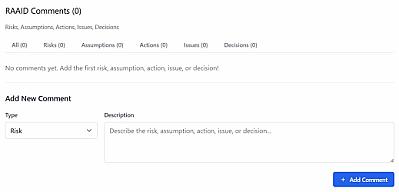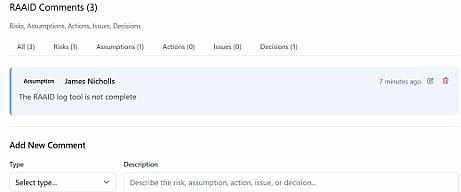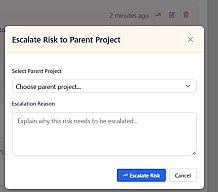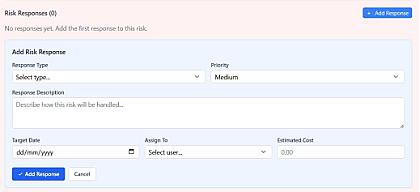Critiquing My Raid Log Template
Published July 7, 2025 • 6 min read
Updated September 27, 2025
Author James Nicholls
Recently, we introduced a feature called RAAID comments to the project board. Have we successfully met the requirements of a RAID log template that can be used for almost any project? We should be able to use Raid logs to break down siloed teams, allowing people to adopt them and talk about them as a proactive part of the project planning as well as an ongoing document.
Why (AA) Actions & Assumptions?
Traditional RAID logs will have either of these, not both. However, from discussions with project managers (PMs), both elements are important to record. Actions for significant things that someone has done, and might replace or enhance our tasks tool one day. Assumptions, regardless of the cause, need clarification as soon as possible, and this should be recorded and acted upon.
Not recording either actions or assumptions was viewed as problematic. Assumptions are infamous for their correlations with making an a** out of you and me.
Basic Recording & Viewing
This is made easy, a primary objective of FinStarty's overall usage. The comment type is selected, and you can now write your comment. This marks the first step.

These are displayed in the order they are made and are easily filterable on the type of comment you have made.

It is simple to update and edit these comments, which can only be updated by the original commenter. Other project management tools allow edits by any user with access to the project, creating confusion.
Risks
Risks could have been transferable to a Risk Register; for now, risks are kept scoped to the project that identifies them.
Escalating risks. The mechanism for this works with the parent-child relationships that Finstarty uses. For example, if I identify a risk in writing a blog and don't feel able to respond to the risk. It can be elevated to a content management project.

And if the Content Manager thinks that it's acceptable for the blog writer to complete a risk response, they can cancel that escalation, or respond or escalate themselves.

Risk Response
Response Type, Priority, Response Description, Ownership (Assigned To) & Estimated Cost of the risk are all recorded.

The function to create projects to manage risks isn't available, and other improvements could come from including a "Probability Score" and "Status". The probability of risks occurring helps create a sense of urgency regarding the risk, and knowing when it is complete prevents it from being analysed when it is no longer required. Both should have been marked as must-have features of the risk response section of the tool.
Being able to create a project from a risk is a good idea, for bigger risks where a simple response is not enough, it would give context to that project, which will help that project set its must-have requirements.
Elapsed risks are something that is not handled and that should be addressed in a follow-up.
Assumptions
These can now be set as true or confirmed, indicating that the assumption is correct. You can collect clarification statements from anyone on the project or in your organisation. This allows you to move on with projects, giving people the opportunity to provide additional information to correct your assumption.
Issue Reporting the Impacts
Impacts could be recorded in the text field alone, and this might be sufficient for your teams. However, creating numerical values of time or money, how much did that issue cost you in total? This can be recorded, and each issue can have multiple impacts recorded.
This can give you a total impact that can be communicated to stakeholders.
Decision Responses
Decision responses are recoded and logged in the system, and regardless of the comment type, that decision is stored and displayed. If you change the comment to an action, you will see the decision that led to it.

To enhance the decision-making responses, you can add stakeholders, which include decision-makers, those consulted, and the people who need to be informed of the decision.

Each update to the decision is logged with the person who has made the change and when.
Actions
A omission, right now, is the status of Actions.
This omission in hindsight was because I did not fully write out the scope of the project, and became very focused on one element. In this case, risk responses could still be improved.
Writing out the must-haves would likely have prevented this! But also a way of enforcing them. Several project management frameworks reference gatekeeping project stages from planning to implementation. There are a couple of additional considerations for FinStarty project management here.
Dependencies
The standard dependencies function for FinStarty is generally acceptable; however, different types of dependencies can exist. The most common type is listed as FS below, while other dependency types have their specific uses. I suggest that these alternative types can sometimes indicate a failure to break down projects into manageable chunks. If only one task in a project depends on another project being completed, there's no need to create a separate project.
In FinStarty, however, you can create a child project that includes this dependency, while the parent project can be incomplete until its essential child projects are finished.
- Finish-to-Start (FS): A task cannot begin until the preceding task is finished.
- Finish-to-Finish (FF): A task cannot be finished until the preceding task is finished.
- Start-to-Start (SS): A task cannot begin until the preceding task has started.
- Start-to-Finish (SF): A task cannot be finished until the preceding task has started.
Risks become issues, issues require a decision
Updating the type of RAAID comment is something you can do. The changes to the comment are shown on the comment
Final Word
This is a good template to begin with, and once the responses are all completed for the missed elements, this RAAID template will put any project manager in good shape.
With the identified risk response fields to be added to the overall tool, it will be highly efficient. It could lead to the creation of a fully fledged risk register with the two project management tools integrated into FinStarty, making life much easier than maintaining a custom spreadsheet or standalone tools that require setup.


